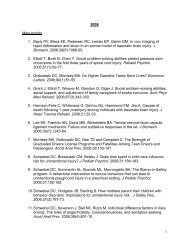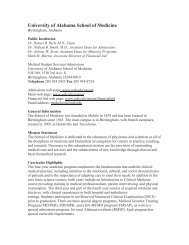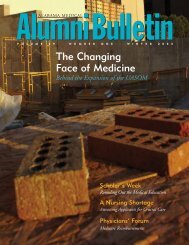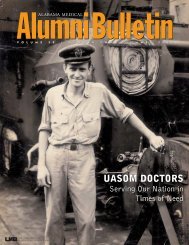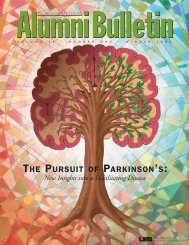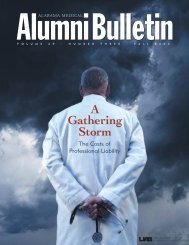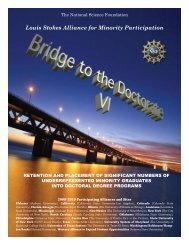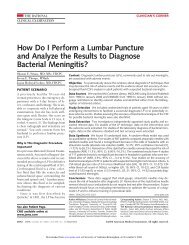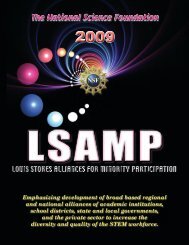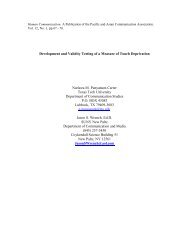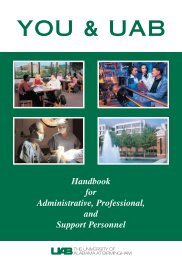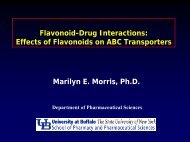In Pursuit of Precision - University of Alabama at Birmingham
In Pursuit of Precision - University of Alabama at Birmingham
In Pursuit of Precision - University of Alabama at Birmingham
Create successful ePaper yourself
Turn your PDF publications into a flip-book with our unique Google optimized e-Paper software.
Fe<strong>at</strong>ure Stories<br />
LOUIS’S LETTERS<br />
ON DISPLAY:<br />
Pasteur’s Search for an Anthrax Vaccine<br />
By Roger Shuler<br />
Michael Flannery finds it difficult to overst<strong>at</strong>e Louis Pasteur’s contributions<br />
to modern medicine. “Pasteur developed the germ theory <strong>of</strong> medicine,<br />
which led to our modern understanding <strong>of</strong> infectious diseases,” says<br />
Flannery, associ<strong>at</strong>e director for historical collections <strong>at</strong> UAB. “He was a<br />
chemist, not a physician, and he was very adept <strong>at</strong> methodology. Through<br />
his investig<strong>at</strong>ions in ferment<strong>at</strong>ion, he developed the pasteuriz<strong>at</strong>ion process<br />
in milk. And he l<strong>at</strong>er engaged in studies <strong>of</strong> anthrax and swine fever.”<br />
When last fall’s terrorist <strong>at</strong>tacks included anthrax-tainted mail, the<br />
world received another reminder <strong>of</strong> Pasteur’s contributions to science.<br />
Now, 17 letters on display <strong>at</strong> UAB’s Reynolds Historical Library provide<br />
insight into Pasteur’s efforts to develop the vaccine for anthrax.<br />
The letters are part <strong>of</strong> a lengthy correspondence between Pasteur, credited<br />
with developing the first vaccine for anthrax, and his disciple Louis<br />
Thuillier. The microbe responsible for the disease had been isol<strong>at</strong>ed in<br />
1876; Pasteur announced the first successful anthrax vaccin<strong>at</strong>ions in<br />
experimental animals in 1881, and he disp<strong>at</strong>ched Thuillier to Germany<br />
and Austria-Hungary for the next two years to further the research effort.<br />
Meanwhile, anthrax was decim<strong>at</strong>ing livestock herds throughout Europe.<br />
“Anthrax is most common in animals, and Pasteur’s first experiments<br />
began with silkworms,” Flannery says. “Silkworms were a major French<br />
industry <strong>at</strong> the time, and it was thre<strong>at</strong>ened by anthrax infections. Pasteur<br />
used the microscope and his experience with ferment<strong>at</strong>ion to establish procedures<br />
for dealing with these infections. L<strong>at</strong>er he worked with cholera and<br />
rabies. He opened a new window into the workings <strong>of</strong> infectious diseases.”<br />
The Pasteur-Thuillier letters were in the collection <strong>of</strong> Lawrence<br />
Reynolds, M.D., an <strong>Alabama</strong> n<strong>at</strong>ive who don<strong>at</strong>ed his extensive library <strong>of</strong><br />
rare medical writings to the <strong>University</strong> <strong>of</strong> <strong>Alabama</strong> School <strong>of</strong> Medicine in<br />
1958. <strong>In</strong> addition, the library holds a copy <strong>of</strong> Correspondence <strong>of</strong> Pasteur<br />
and Thuillier, Concerning Anthrax and Swine Fever Vaccin<strong>at</strong>ions, published<br />
in 1968 by the <strong>University</strong> <strong>of</strong> <strong>Alabama</strong> Press.<br />
<strong>In</strong> the time period covered by the letters, Thuillier conducted a series<br />
<strong>of</strong> vaccin<strong>at</strong>ions against anthrax in sheep and c<strong>at</strong>tle in Germany and<br />
Austria-Hungary. It is believed th<strong>at</strong> Pasteur intended to conduct the vaccin<strong>at</strong>ions<br />
himself but was constrained by other responsibilities. He relied<br />
on Thuillier as a surrog<strong>at</strong>e, prompting a steady stream <strong>of</strong> letters th<strong>at</strong><br />
detailed the successes, failures, and obstacles encountered in the project.<br />
“The letters are clearly a correspondence between a senior scientist and<br />
a younger, developing colleague,” Flannery says. “Thuillier is <strong>at</strong> a distance,<br />
and he’s asking for advice. Pasteur <strong>of</strong>ten says, ‘If this doesn’t work, try this.’<br />
The letters are pr<strong>of</strong>essional exchanges between a mentor and a protégé.”<br />
Pasteur’s discovery th<strong>at</strong> most infectious diseases are caused by germs is<br />
one <strong>of</strong> the most important in medical history. His work, supported by<br />
the l<strong>at</strong>er studies <strong>of</strong> German Robert Koch, became the found<strong>at</strong>ion for the<br />
science <strong>of</strong> microbiology and a cornerstone <strong>of</strong> modern medicine.<br />
“The general notions <strong>of</strong> disease were very unclear until Pasteur, along<br />
with Koch, began to flesh them out,” Flannery says. “It was believed th<strong>at</strong><br />
diseases were carried by strange vapors or bad air. <strong>In</strong> fact, the term malaria<br />
means, literally, ‘bad air.’ Scientists, <strong>at</strong> the time, did not know th<strong>at</strong> many<br />
<strong>of</strong> these diseases were actually caused by germs. When these microorganisms<br />
became known, it was thought th<strong>at</strong> they grew from spontaneous gener<strong>at</strong>ion.<br />
Pasteur’s work demolished th<strong>at</strong> notion and went on to show th<strong>at</strong><br />
specific microorganisms were responsible for specific diseases.”<br />
David Green and Manisha Sharma (president,<br />
class <strong>of</strong> 2005) join classm<strong>at</strong>es in recognizing<br />
the generosity <strong>of</strong> donors and their families.<br />
11<br />
change their minds after <strong>at</strong>tending the memorial<br />
service. “When they hear the heartfelt<br />
comments <strong>of</strong> the students, it drives home how<br />
vital these donors are for medical students’<br />
educ<strong>at</strong>ion,” says Casey.<br />
Heinz Dueffer, a first-year student who<br />
helped organize this year’s service, says th<strong>at</strong> families<br />
are comforted by the respect the students<br />
express for their loved ones. “The approach is,<br />
these are our first p<strong>at</strong>ients, and we need to take<br />
very good care <strong>of</strong> them,” he says. “The family<br />
members are thankful and impressed with how<br />
gr<strong>at</strong>eful we are for wh<strong>at</strong> their loved ones did.”<br />
Several members <strong>of</strong> the Class <strong>of</strong> 2005 are<br />
musicians, so this year’s service included performances<br />
by a pianist, a singer, and a cello<br />
player in the class. Students lit a candle for each<br />
<strong>of</strong> the donors as their names were read. Some<br />
students read tributes to the donors.<br />
“Knowledge <strong>of</strong> the human body is essential<br />
in the undertaking <strong>of</strong> our lives as physicians,”<br />
said Dave Williams. “However, the other gift<br />
they gave to us—the example <strong>of</strong> unselfish giving<br />
to our fellow mankind—may be even<br />
more important, both in our future practices<br />
and in our everyday lives.”<br />
Another student, Suman Annambhotla,<br />
said, “All my life I have been taught the idea <strong>of</strong><br />
selfless love and giving, but there is no gift<br />
more selfless than this.”



